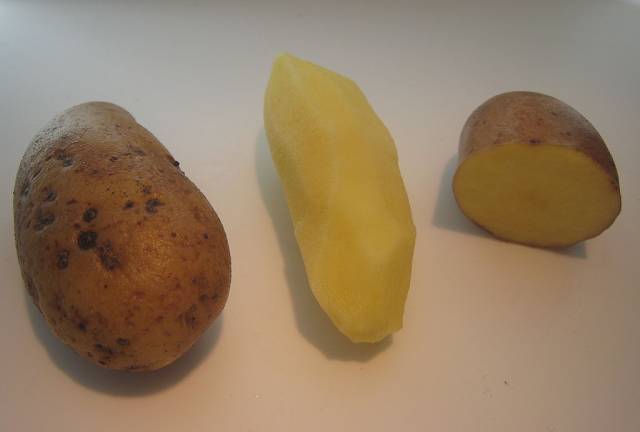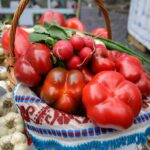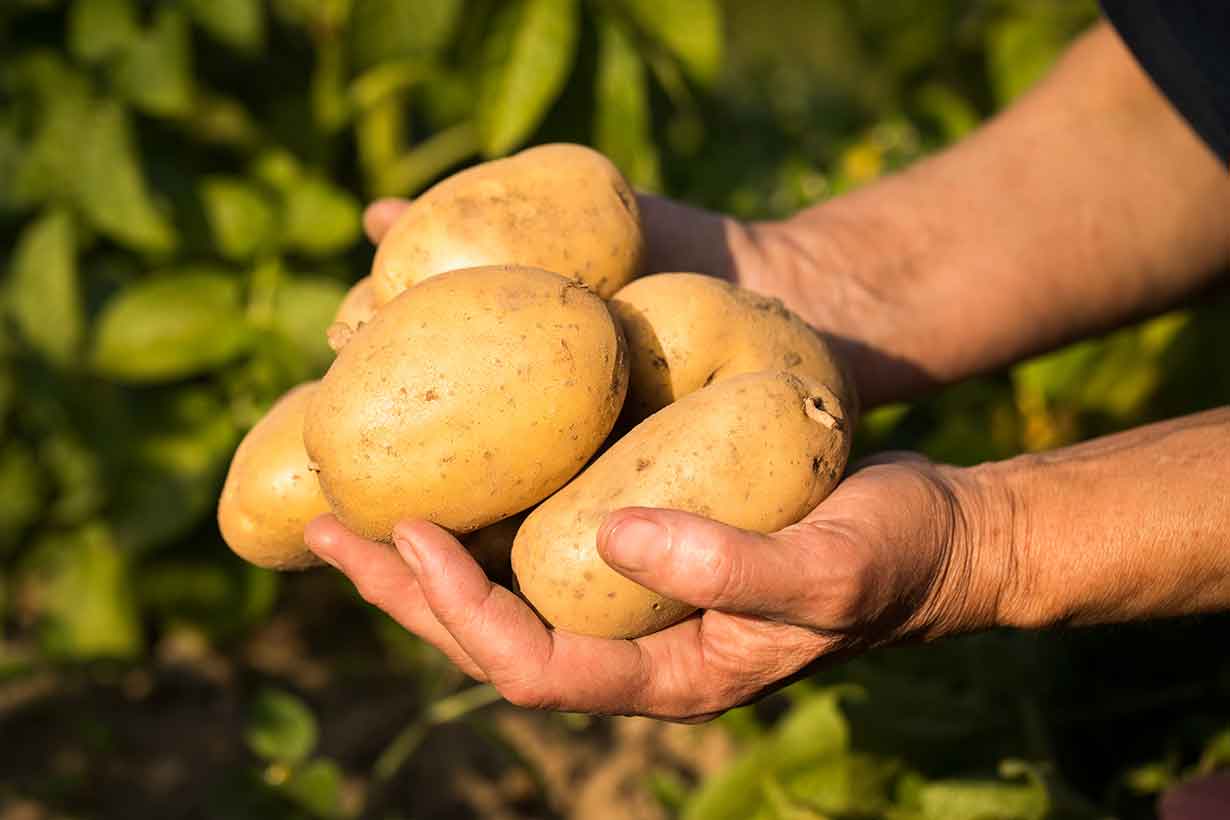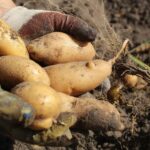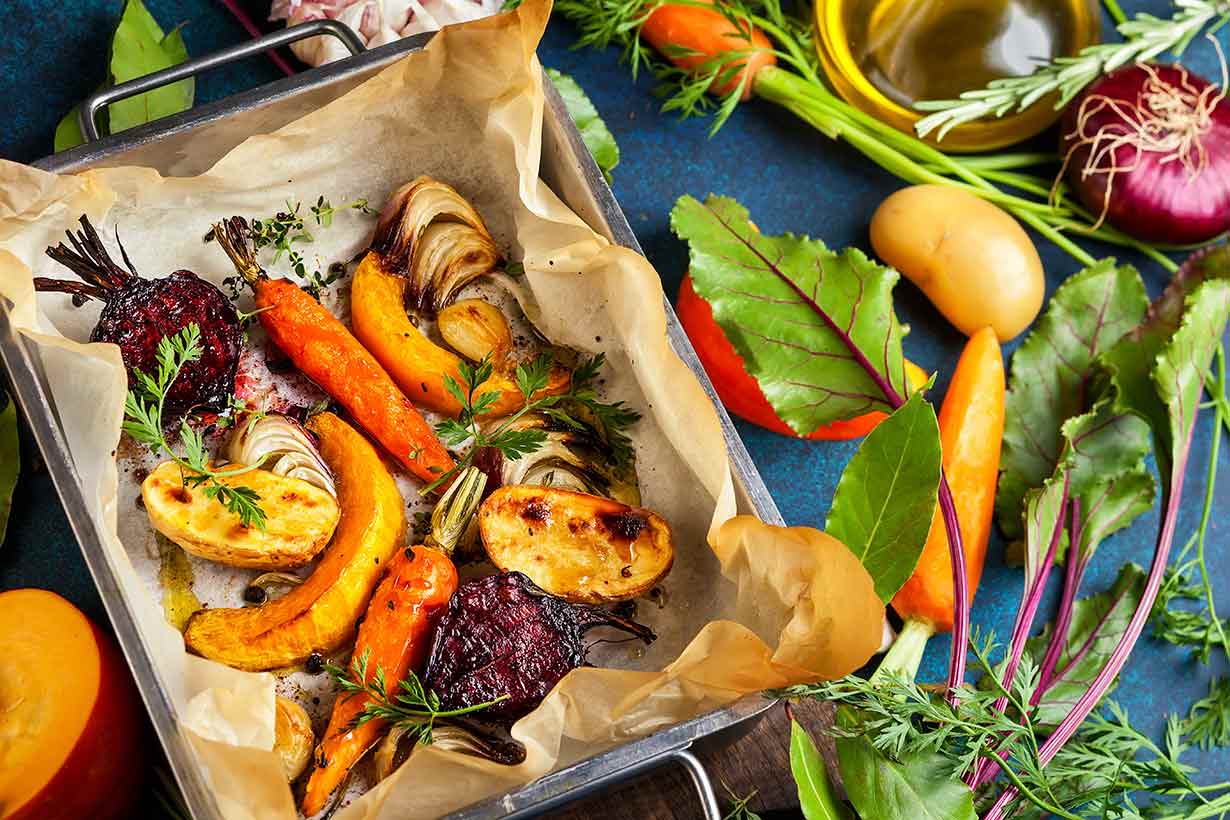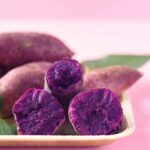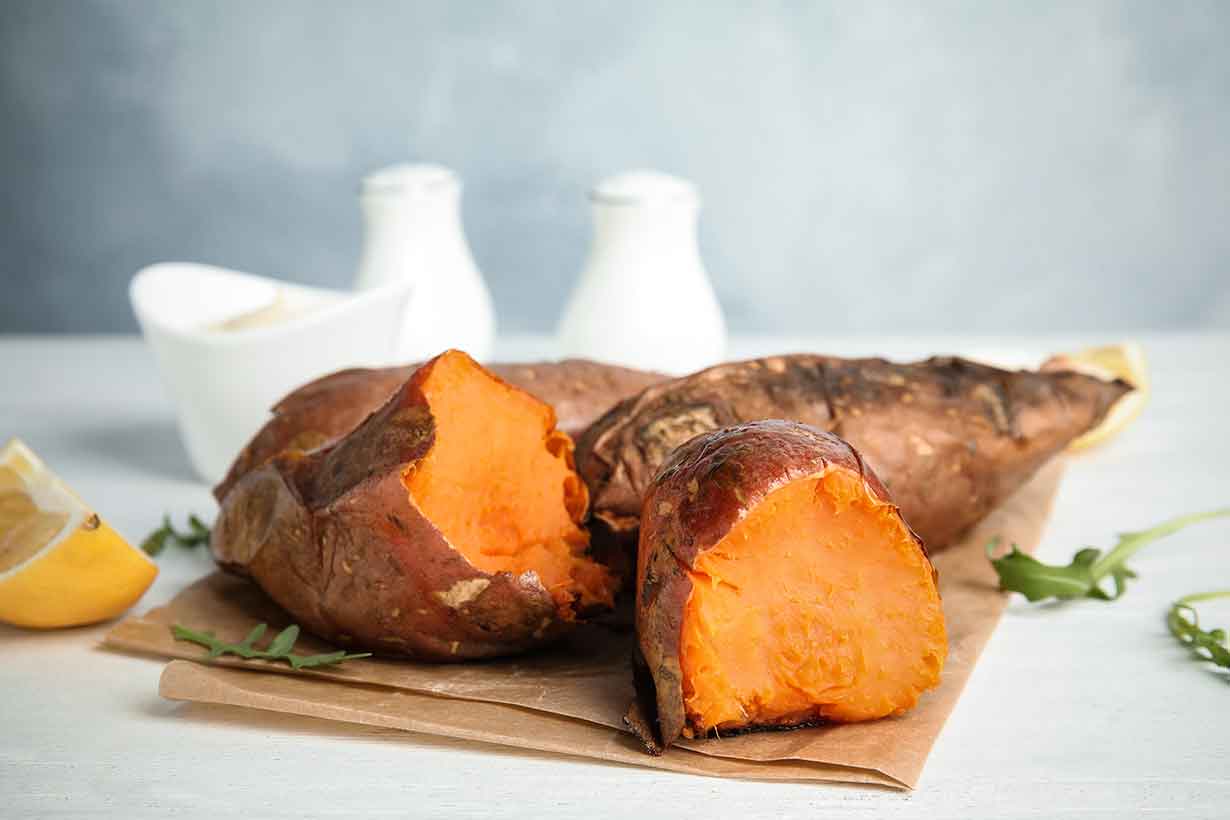Potatoes are delicious. They’re a staple food in many countries around the world and an excellent source of nutrients too.
The earliest origins of the humble potato go back to South America, with cultivation first taking place in Peru somewhere between 8,000 BC and 5,000 BC (1).
Yet not all potatoes are the same; there are many different types of potatoes that each have a unique appearance, taste, and texture. Some of these potatoes are white and fluffy, some are red and firm, and some are even blue.
This guide lists the most popular types of potatoes around the world, their properties, and how to use them.
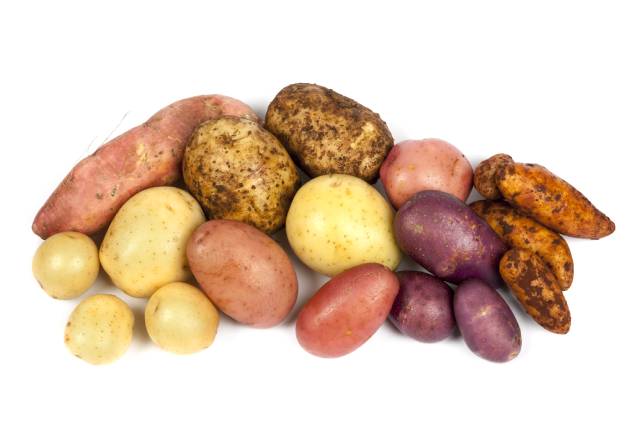
Main Potato Varieties
First of all, there are five main categories of potatoes, and these include the following:
- White potatoes: the most common variety of potatoes has a white to yellow flesh and thin skin. While their texture can vary depending on the specific type, white potatoes are good all-rounders, and they are good options for baking, boiling, frying, mashing, and roasting.
- Russet potatoes: Russets are white inside with a thick and chewy skin. These potatoes are usually starchy, and they are soft and fluffy after being cooked. Russets are often used for making baked potatoes.
- Red potatoes: these potatoes have red skin but a white flesh. They generally have a firm texture and include cultivars such as Désirée and Laura.
- Purple/blue potatoes: there are several varieties of potato that have an attractive blue-to-purple flesh, with Blue Congo and Vitelotte cultivars being notable examples. These potatoes contain many polyphenols known as anthocyanins, and these compounds are responsible for the color (1).
- Fingerling potatoes: these potatoes have a long and thin appearance, thin skin, and a firm texture. Fingerling species are often boiled, pan-fried, or roasted.
Despite their name, sweet potatoes (and yams) are botanically distinct from regular potatoes, and they belong to the category of root vegetables.
Waxy vs. Starchy
We can also judge potatoes by how ‘waxy’ they are, which mainly signifies their texture and appropriate culinary uses. In this regard, some potatoes are ‘waxy,’ and they have a lower starch content and a higher moisture level. These potatoes have firmer flesh, and they are suitable for boiling, roasting, and well-suited as an ingredient for soups and stews.
In contrast, ‘starchy’ potatoes contain more starch and less moisture, and they have a fluffy texture that easily crumbles. Such potatoes are well-suited for baking, mashing, and making chips/fries.
Some potatoes are somewhat in between these two classifications, and people usually call them ‘all-rounders.’
Types of Potatoes
In truth, there are thousands of different types of potatoes native to various countries around the world.
However, here are some of the most famous potatoes you may find (or decide to grow).
1) Almond
- Name: Almond potato
- Variety: Fingerling
- Country of Origin: Sweden
- Texture: Firm
- Shape: small, oblong-shaped
- Color: White flesh with thin skin
- Culinary Uses: pan-frying, boiling, roasting
The almond potato is popular among Scandinavian countries, and it is also known as the ‘Swedish peanut fingerling.’
It is a type of fingerling potato with a firm texture. Almond potatoes keep their shape well, which makes them suitable for roasting, pan-frying, and boiling.
2) Bamberg
- Name: Bamberg potato
- Variety: Russet
- Country of Origin: Germany
- Texture: Firm, waxy
- Shape: Long and thin
- Color: Light yellow flesh, brown skin
- Culinary Uses: pan-frying, boiling, roasting
The Bamberg is a small potato with a long, thin shape, and it has a reasonably firm texture.
As a result, it is commonly used for making boiled, roasted, and steamed potatoes.
Bamberg potatoes have a thin skin and a custard yellow-colored flesh.
3) Belle de Fontenay
- Name: Belle de Fontenay
- Variety: Fingerling
- Country of Origin: France
- Texture: Firm, waxy
- Shape: Small, long, and oblong-shaped.
- Color: Light yellow flesh and skin
- Culinary Uses: boiling, roasting, soups, and stews
Belle de Fontenay is a common French potato, and it is usually served whole, either alone or in soups and stews.
4) Bintje
- Name: Bintje
- Variety: White
- Country of Origin: Netherlands
- Texture: Soft and fluffy
- Shape: Large and thick oval shape
- Color: Creamy yellow flesh and similar skin
- Culinary Uses: French fries, roast potatoes
Bintje potatoes are famous in the Netherlands, where they are often used for making French fries.
They are seen as a good ‘all-rounder,’ and they are also used for making roasted potatoes.
5) Blue Congo
- Name: Blue Congo
- Variety: Blue/purple
- Country of Origin: Unknown
- Texture: Soft and moist
- Shape: Large and oval
- Color: Deep blue flesh and skin
- Culinary Uses: Mashed potato, casseroles
Blue congo potatoes have a unique, deep blue appearance, and they have a flavorful and somewhat nutty taste.
The origin of these potatoes is unknown, but they are closely associated with several types of potatoes from Canada (2).
Blue congo potatoes contain high moisture levels, and they are very soft when cooked. For this reason, they work well for making mashed potatoes to eat alone or as part of a dish.
6) Désirée
- Name: Désirée
- Variety: Red
- Country of Origin: Netherlands
- Texture: Medium firm
- Shape: Medium size, round to oval
- Color: White flesh and red skin
- Culinary Uses: Boiling, mashing, roasting, steaming
Désirée potatoes are seen as all-rounders as they are somewhere in between waxy and starchy.
The potatoes have dull red skin and white flesh that is reasonably firm once cooked, so they are quite versatile cooking potatoes.
7) Gala
- Name: Gala potato
- Variety: White
- Country of Origin: Germany
- Texture: Firm
- Shape: Large and oval
- Color: Cream to light yellow
- Culinary Uses: Boiling, roasting, steaming
Gala potatoes are a popular German potato with a firm texture, and they are well-suited to dishes calling for whole potatoes.
After boiling or steaming these potatoes, they retain their shape well.
8) Golden Wonder
- Name: Golder Wonder
- Variety: Russet
- Country of Origin: Scotland
- Texture: Soft and fluffy
- Shape: Large, oblong to oval-shaped
- Color: Creamy with a light skin
- Culinary Uses: Mashing, chips/fries, roasting
Golden wonder potatoes are incredibly starchy, and this gives them a soft texture that can easily crumble apart.
For this reason, they tend to be used for making mashed or roasted potatoes, and they are not well-suited for boiling.
Golden wonder potatoes are very flavorful and are viewed as one of the best culinary potatoes.
9) Home Guard
- Name: Home Guard
- Variety: White
- Country of Origin: United Kingdom
- Texture: Firm
- Shape: Small to medium-sized, round to oval
- Color: White flesh and thin beige skin
- Culinary Uses: Boiling, steaming, pan-frying, soups and stews
Home guard potatoes originated in the UK, and they’re generally small to medium in size and quite firm-fleshed.
The potatoes are a waxy variety, so they won’t disintegrate when used for boiling or in soups and stews.
Home guard potatoes were introduced in 1942 during the Second World War, hence their ‘home guard’ name (3).
10) Irish Lumper
- Name: Irish Lumper
- Variety: White
- Country of Origin: Ireland
- Texture: Quite firm
- Shape: Medium-sized, lumpy texture
- Color: White flesh and pale yellow skin
- Culinary Uses: All-rounder
The Irish Lumper is an old potato first introduced in Ireland during the early part of the 19th century (4).
These potatoes are waxy and medium-firm, which makes them an excellent multi-purpose cooking potato.
Regarding their appearance, the Irish Lumper has a bumpy, lumpy texture, which might explain their name.
Interestingly, the Irish Lumper disappeared for many decades after the Irish famine of the 1830s. It has recently started being regrown over recent years (5).
11) Jersey Royal
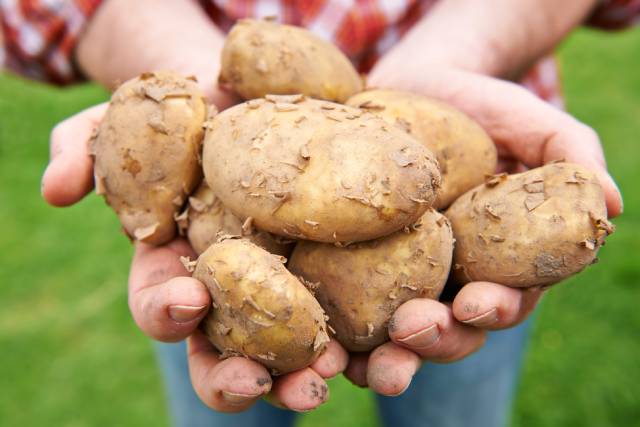
- Name: Jersey Royal
- Variety: White
- Country of Origin: Jersey
- Texture: Firm
- Shape: Small to medium, kidney-shaped.
- Color: White flesh and pale yellow skin
- Culinary Uses: Boiling, steaming, salads, stews
Jersey Royal potatoes have a protected designation of origin (PDO), and they grow on the island of Jersey (6).
These famous potatoes are small to medium in size, and they retain their shape well during cooking.
Jersey potatoes are often pan-fried with a little butter and some herbs, and they have a soft but firm texture and a flavorful taste.
12) Kennebec
- Name: Kennebec potatoes
- Variety: White
- Country of Origin: United States
- Texture: Medium-firm
- Shape: Medium-sized, oblong to round in shape
- Color: White flesh and pale yellow skin
- Culinary Uses: All-rounder
Kennebec potatoes are medium in size and almost round-shaped.
The potato was first bred in the first half of the 20th century, and it remains popular to this day (7).
Kennebec potatoes are an all-purpose potato that can be boiled, roasted, mashed, or used in soups and stews. They have a slightly nutty taste.
13) Kerr’s Pink
- Name: Kerr’s Pink
- Variety: White
- Country of Origin: Scotland
- Texture: Quite soft
- Shape: Round to oval in shape, medium to large
- Color: Creamy flesh and a red skin
- Culinary Uses: Boiling, mashing, roasting
Kerr’s Pink potatoes are a red-skinned potato with pale creamy flesh, and they are one of the world’s most popular potatoes.
First grown Scotland during 1917, they still account for an estimated 25% of Ireland’s total potato production to this day (8).
The potatoes have a soft texture and a mild flavor.
14) King Edward
- Name: King Edward
- Variety: White
- Country of Origin: England
- Texture: Soft and fluffy
- Shape: Large-sized and oval
- Color: Cream-colored flesh and a thin skin
- Culinary Uses: Baking, mashing, roasting,
King Edward potatoes are one of the oldest culinary potatoes, having first been introduced in 1902 (9).
Due to their high-starch levels, these potatoes are very soft and fluffy after cooking, and they work well for making mashed, baked, or roasted potatoes.
As well as this, they are one of the most popular potato varieties for making chips/fries.
15) Kipfler
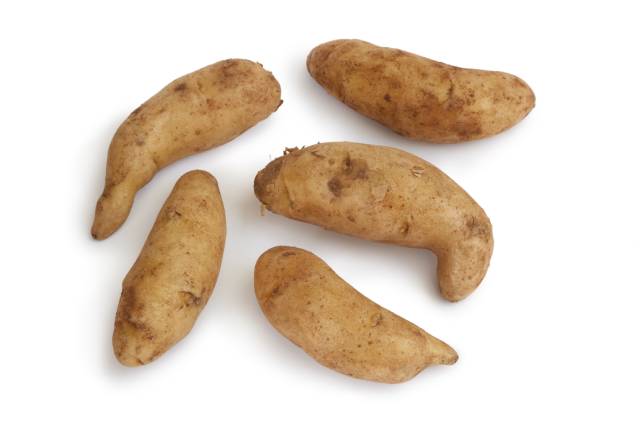
- Name: Kipfler
- Variety: Fingerling
- Country of Origin: Germany
- Texture: Soft and creamy
- Shape: Relatively large, long, and thin
- Color: Light yellow flesh and a light brown skin
- Culinary Uses: Baking, roasting,
Kipfler is a Germany variety of fingerling potatoes that has a long and thin shape.
The potatoes are very soft once cooked, and they have a creamy and slightly nutty taste.
Due to their texture, the potatoes are best-suited for making baked and roasted potatoes.
16) Laura
- Name: Laura
- Variety: Red
- Country of Origin: Austria
- Texture: Firm
- Shape: Large, long, and oval-shaped
- Color: Rich yellow flesh and deep red skin.
- Culinary Uses: Boiling, mashing, pan-frying, roasting, soups and stews
The Laura potato is a red-skinned potato variety that was introduced relatively recently. The potato has only been grown since 1998 (10).
It is reasonably versatile as an all-rounder and can be used in a variety of ways.
17) Marcy
- Name: Marcy
- Variety: White
- Country of Origin: United States
- Texture: Moderately firm
- Shape: Large, thick, and oval-shaped
- Color: White flesh and light brown skin
- Culinary Uses: Good all-rounder: baking, boiling, frying, and more.
The Marcy potato is a relatively modern species, having first been introduced to the United States in 1990 (11).
The potato is large and almost round-shaped, and it has white flesh and a light beige to brown skin.
Marcy potatoes are quite firm, but as they are somewhere in between waxy and starchy, they are versatile enough for a range of culinary preparations.
18) Marfona
- Name: Marfona
- Variety: White
- Country of Origin: Netherlands
- Texture: Medium-soft, slightly fluffy
- Shape: Medium-sized and oval to round in shape
- Color: Pale yellow flesh with a thin skin
- Culinary Uses: Baking, boiling, mashing, and steaming
Like so many other types of potatoes, the Marfona first came from the Netherlands (the Dutch consume significant amounts of potatoes).
The potato has a slightly waxy texture, and it becomes fluffy when cooked. However, it is noted for its all-round versatility, and it is firm enough for boiling.
Marfona potatoes have a creamy and flavorful taste, making them a good choice for boiled potatoes. They are also one of the best potatoes for baking due to their size and light and fluffy texture.
19) Maris Piper
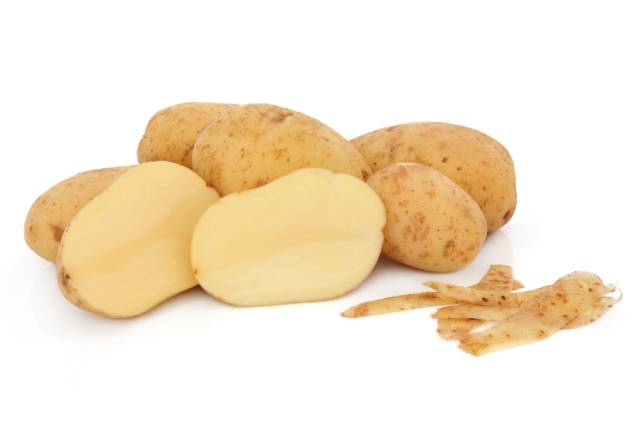
- Name: Maris Piper
- Variety: White
- Country of Origin: England
- Texture: Soft and fluffy
- Shape: Medium-sized, round-to-oval
- Color: Cream-colored flesh with a light skin
- Culinary Uses: Baking, boiling, roasting, chips/fries,
The Maris Piper is the most common type of potatoes that grows within the United Kingdom, with approximately triple the planted area of any other potato (12).
Maris Piper potatoes are noted for their all-round versatility, and their fluffy texture works well for baked and roasted potatoes, as well as for making chips (fries).
However, they are also firm enough to boil while retaining their shape.
20) Melody
- Name: Melody
- Variety: White
- Country of Origin: Netherlands
- Texture: Firm
- Shape: Long, oval, medium to large
- Color: Light yellow flesh and skin
- Culinary Uses: Boiling and mashing
Melody potatoes were first grown in the Netherlands.
Since they are quite starchy, they are typically used for making soft boiled potatoes and mashed potatoes.
These potatoes have a long oval shape and a light skin.
21) Nicola
- Name: Nicola
- Variety: White
- Country of Origin: Germany
- Texture: Firm
- Shape: Long oval to oblong shape
- Color: Creamy yellow flesh and skin
- Culinary Uses: All-rounder: boiling, mashing, roasting, and more
Nicola potatoes are a popular German species, and they were first recognized as a variety of potato in 1973. Interestingly, the Nicola potato was also recognized in 2016 as German ‘potato of the year’ due to its high-quality flavor (14).
These potatoes are more on the waxy side, so they are firm and keep their texture when boiled. However, they are versatile and also work well for baking and roasting.
22) Ozette
- Name: Ozette
- Variety: Fingerling
- Country of Origin: USA
- Texture: Firm, smooth
- Shape: Odd-looking: lumpy and no set shape
- Color: Creamy white flesh and light brown skin
- Culinary Uses: Multi-purpose – baking, boiling, mashing, roasting, and more.
The Ozette potato is a centuries-old potato thought to have first been recognized in Washington, United States (15).
Ozette potatoes belong to the fingerling variety of potato, but they have a highly irregular shape with numerous lumpy bumps. Despite their visual appearance, the Ozette potato is a flavorful option with a slightly nutty taste.
They have a waxy consistency, but they’re considered an all-rounder, and they work well whether mashed, baked, roasted, or pan-fried.
23) Pink Fir Apple
- Name: Pink Fir Apple potato
- Variety: Fingerling
- Country of Origin: France
- Texture: Firm
- Shape: Long, thin, bumpy, irregular
- Color: Creamy white flesh with a pinkish-brown skin
- Culinary Uses: Boiled or steamed potatoes, soups, and stews
The Pink Fir Apple potato has a long and knobbly texture, but they are renowned for their rich and nutty flavor (16).
These potatoes tend to be on the more expensive side if you can find them in grocery stores.
24) Ranger Russet
- Name: Ranger Russet
- Variety: Russet
- Country of Origin: United States
- Texture: Soft and fluffy
- Shape: Large and oval-shaped
- Color: White flesh and dusty-brown skin
- Culinary Uses: Baked potatoes, fries/chips
Ranger Russet potatoes are large and have a consistent, regular oval shape.
The potatoes are very starchy, and they have a soft and fluffy flesh and a chewy skin once cooked. These characteristics make them perfect for making baked potatoes.
25) Ratte
- Name: Ratte
- Variety: Fingerling
- Country of Origin: Debated: Denmark or France
- Texture: Firm
- Shape: Small and long
- Color: Pale yellow skin and flesh
- Culinary Uses: Boiled potatoes, soups, and stews
Ratte potatoes are widely considered to be among the best-tasting types of potatoes.
Due to their rich flavor, they’re one of the best-suited varieties for making boiled potatoes.
Since they are very popular and have low production yields, Ratte potatoes tend to be rather expensive (17).
26) Red Gold
- Name: Red Gold
- Variety: Red potato
- Country of Origin: Canada
- Texture: Creamy, moist, smooth
- Shape: Medium, round-to-oval-shaped
- Color: Red skin and yellow flesh
- Culinary Uses: Baking, boiling, mashing, roasting,
Red Golds are delicious potatoes from Canada that are good all-rounders: they’re suitable for most cooking methods.
Agriculture Canada developed the potatoes together with the University of Guelph and the Ontario Ministry of Agriculture and Food in 1970. They were first recognized/registered in 1987 (18).
Red Gold potatoes have a distinctive yellow flesh and a mild nutty taste.
27) Rooster
- Name: Rooster
- Variety: Red potato
- Country of Origin: Ireland
- Texture: Soft, fluffy
- Shape: Medium to large, round-to-oval-shaped
- Color: Red skin and light yellow flesh
- Culinary Uses: Baking, boiling, mashing, roasting,
Rooster potatoes are a popular Irish variety of red potato.
The flesh has a light yellow color and a starchy consistency, but the potato is a good all-rounder.
Rooster potatoes can be used for various purposes in the kitchen, from making boiled, baked, and roasted potatoes to their use in various dishes.
These potatoes were first introduced in 1993 after being developed by the Irish Ministry of Agriculture (19).
28) Russet Burbank
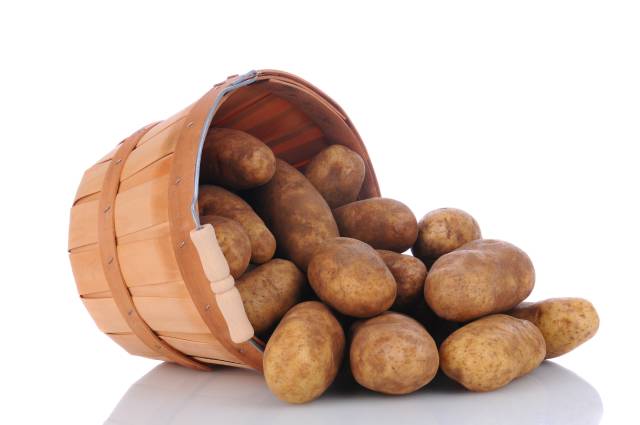
- Name: Russet Burbank
- Variety: Russet
- Country of Origin: United States
- Texture: Soft, dry, starchy
- Shape: Medium-sized, long oval shape
- Color: White flesh and brown skin
- Culinary Uses: Baking, mashing, chips/fries
Russet Burbank potatoes are one of the oldest types of potatoes around the world. These famous potatoes were likely first introduced commercially in 1902 (20).
Like other russet varieties, Russet Burbank potatoes have a thick skin and a soft and fluffy flesh once cooked. Such qualities make them perfect for baking or roasting.
29) Superior
- Name: Superior
- Variety: White potato
- Country of Origin: United States
- Texture: Moderately firm
- Shape: Round to oval shape, consistent size
- Color: White flesh and light skin
- Culinary Uses: All-rounder – baking, boiling, mashed, making chips/fries
The Superior potato was first released in 1961 after being bred by the University of Wisconsin (21).
It is medium to large, and the size doesn’t generally vary between potatoes.
These potatoes are often used for baking, but they’re a versatile variety that can be used for various purposes.
30) Umatilla Russet
- Name: Umatilla Russet
- Variety: Russet
- Country of Origin: United States
- Texture: Soft and fluffy
- Shape: Long oblong shape, slightly irregular
- Color: Creamy flesh and light brown skin
- Culinary Uses: Often used for making French fries
The Umatilla Russet is a popular potato that is frequently used to make fries, and it was released in 1998 (22, 23).
Like other Russet varieties of potato, it has soft and slightly dry flesh, thereby making it a good baked potato option too.
31) Vitelotte
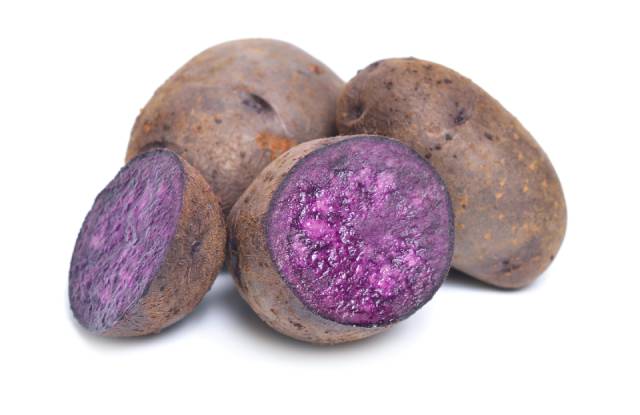
- Name: Vitelotte
- Variety: Blue/purple potato
- Country of Origin: France
- Texture: Soft, dry, and floury
- Shape: Long to round, lumpy, and not uniform in size
- Color: Blue to purple flesh, and dark almost-black skin
- Culinary Uses: Baking, boiling, frying, mashing
Vitelotte potatoes are a French variety of blue/purple potatoes with an attractive visual appearance. The cultivation of these potatoes goes back to the year 1815 in France (24).
Since Vitelotte potatoes are so soft and starchy, they can easily be mashed and mixed into various stews and soups.
Also, they are frequently used to make purple potato chips (crisps).
32) Vivaldi
- Name: Vivaldi
- Variety: White
- Country of Origin: Netherlands
- Texture: Firm, but soft and creamy
- Shape: Small to medium, round to oval shape
- Color: Light yellow flesh and skin
- Culinary Uses: Boiling, mashing, steaming
The Vivaldi is another popular Dutch potato cultivar that is generally small to medium in size.
These potatoes have a mild and buttery flavor, and they are mainly used for making boiled or mashed potatoes.
33) Yukon Gold
- Name: Yukon Gold
- Variety: White
- Country of Origin: Canada
- Texture: Moderately firm, soft, fluffy
- Shape: Medium to large, oval/round shape
- Color: Light golden yellow color and skin
- Culinary Uses: Baking, boiling, mashing, pan-frying, roasting
Yukon Gold is one of the most popular types of potato, and they are an excellent culinary all-rounder.
Thanks to their texture and starch content, they are soft enough to work well as baked potatoes. However, they’re also firm enough to make great boiled or pan-fried potatoes too.
Yukon Gold potatoes were commercially released in Canada in 1980, and they are still widespread now (25).
Interestingly, as yellow-fleshed vegetables, they appear to have higher vitamin A content than white-flesh potatoes.
Where To Buy These Varieties of Potatoes
It can be challenging to find more than several different potatoes in the local grocery store or supermarket.
However, a quick Google search can easily pull up some local specialized sellers of each specific variety.
Additionally, for gardening enthusiasts and would-be home growers, it’s easy to find seeds for the vast majority of these potatoes online.
Final Thoughts
Most of us just think of potatoes as one thing: potatoes.
However, as this article shows, there are so many different varieties of potato, and each has its distinct properties.
Hopefully, this guide will provide better insight into what to do with each type of potato and offer some interesting new options to try.
For more guides to vegetables, see this vegetable nutrition resource.
References
In addition to the references linked to in this article, much of the general information was courtesy of a book called ‘The Complete Book of Potatoes’ by Hielke De Jong.
The book is more of a resource for those who are interested in gardening and growing potatoes, but it provides lots of useful information.
For anyone interested, it is available here (disclosure: affiliate link)

